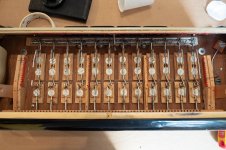breezybellows
Well-known member
I just purchased this from Liberty Bellows. It was listed for a very attractive price. On top of that Mike was very flexible in accepting a couple of trades (hohner xs that my daughters used) to bring the price down further.
They were not able to provide a lot of information about the model.
I'm interested to find out more about this model from others that are more familiar with Bugari models. I expect it to be delivered next week.
1) how old is this model?
2) is this a converter or a transformer? Based on the extra buttons, I guess it's a transformer.
3) any guesses on who the reed maker was?
 www.libertybellows.com
www.libertybellows.com
cc @debra
They were not able to provide a lot of information about the model.
I'm interested to find out more about this model from others that are more familiar with Bugari models. I expect it to be delivered next week.
1) how old is this model?
2) is this a converter or a transformer? Based on the extra buttons, I guess it's a transformer.
3) any guesses on who the reed maker was?
6869 - Black Decorated Bugari Armando Champion Casotto Convertor C Piano Accordion LMMH 41 127
Type: Piano Accordion Reeds: 4/6 LMMH A442Hz +2 Cents Treble: 41 Keys, 19.25(49cm) Key to Key, 13+M Registers Bass: 127 Bass Buttons (69 Convertor buttons - 52 Convertor Tones, E-G), Low E Bass, 7 Registers Weight: 31.5lbs / 14.25kg
cc @debra

